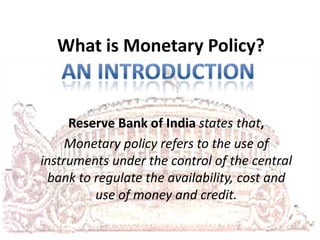
Monetary policy in India a brief
- 1. What is Monetary Policy? Reserve Bank of India states that, Monetary policy refers to the use of instruments under the control of the central bank to regulate the availability, cost and use of money and credit.
- 2. Operations to regulate monetary policy • • • • • • Open Market Operations Cash Reserve Ratio (CRR) Statutory Liquidity Ratio (SLR) Repo Rate and Reverse Repo Rate Bank Rate Liquidity Adjustment Facility (LAF)
- 3. Open market Operations • An open market operation is an instrument of monetary policy which involves buying or selling of government securities from or to the public and banks. This mechanism influences the reserve position of the banks, yield on government securities and cost of bank credit
- 4. CRR • Cash Reserve Ratio is a certain percentage of bank deposits which banks are required to keep with RBI in the form of reserves or balances .Higher the CRR with the RBI lower will be the liquidity in the system and viceversa. As of today, the CRR is 4.00 percent.[3]
- 5. SLR • Every financial institution has to maintain a certain quantity of liquid assets with themselves at any point of time of their total time and demand liabilities. These assets can be cash, precious metals, approved securities like bonds etc. The current SLR is 23%.
- 6. Bank Rate The bank rate, also known as the discount rate, is the rate of interest charged by the RBI for providing funds or loans to the banking system. Increase in Bank Rate increases the cost of borrowing by commercial banks which results into the reduction in credit volume to the banks and hence declines the supply of money. As of today, the bank rate is 9.00%
- 7. REPO RATE AND REVERSE REPO RATE • Repo rate is the rate at which RBI lends to commercial banks generally against government securities. Reverse Repo rate is the rate at which RBI borrows money from the commercial banks. This increase in Repo Rate and Reverse Repo Rate is a symbol of tightening of the policy. As of today, the repo rate is 8.00 % and reverse repo rate is 7.00%.
- 8. Liquidity Adjustment Facility (LAF): Consists of daily infusion or absorption of liquidity on a repurchase basis, through repo (liquidity injection) and reverse repo (liquidity absorption) auction operations, using government securities as collateral.
- 10. Bank Rate • The bank rate has been increased from 8.75% , October 2013 to 9.00%, current. • This has lead to reduction in borrowings and increase in interest rates charged by commercial banks. • Due to increase in bank rate, the supply of money has come down. • The increase in the policy repo rate under the liquidity adjustment facility (LAF) by 25 basis points from 7.25 per cent to 7.5 per cent with immediate effect. • The RBI in its annual monetary policy statement said there would be modest improvement in the country's economic growth to 5.7 per cent in the current fiscal, as against the decade's low of 5 per cent in 2012-13.
- 11. • It has been decided to reduce the minimum daily maintenance of the cash reserve ratio (CRR) from 99 % of the requirement to 95 % effective from the fortnight beginning September 21, 2013, while keeping the CRR unchanged at 4.0 per cent. • This reduction (in CRR from 5.5 per cent to 4.75 per cent) injected around Rs 48,000crore of primary liquidity into the banking system. (Rs 16000crores for every 25 basis points cut in CRR)
- 12. • Reduce the marginal standing facility (MSF) rate by 75 basis points from 10.25 per cent to 9.5 per cent with immediate effect; • The RBI in its annual monetary policy statement said there would be modest improvement in the country's economic growth to 5.7 per cent in the current fiscal, as against the decade's low of 5 per cent in 2012-13.
- 13. • The RBI says assessment of growth-inflation dynamics limits scope for further easing of policy rate. • FY14 GDP growth pegged at 5.7 per cent, down from government's estimates. • CAD is the biggest risk to the economy. • RBI proposes doubling of limits on priority sector lending to MSMEs to Rs 5 Crore. • Sticking to its cautious stance, the Reserve Bank on Friday cut the key interest rate by just 0.25 percent to 7.25 percent and kept the liquidity enhancing cash reserve requirement unchanged, disappointing the industry and stock market. The RBI in its annual monetary policy statement said there would be modest improvement in the country's economic growth to 5.7 percent in the current fiscal, as against the decade's low of 5 percent in 2012-13.
- 14. Change in CRR… why? In the third quarter review of January 2012 CRR was reduced, to mitigate tight liquidity conditions, by 50 basis points leading to increase in liquidity by Rs.480 billion into the banking system.
- 15. How does monetary policy affect inflation and other problems?
- 16. SELECTIVE/ QUALITATIVE MEASURES • The RBI directs commercial banks to meet their social obligations through selective/ qualitative measures. • These measures control the distribution and direction of credit to various sectors of the economy. CEILING ON CREDIT MARGIN REQUIREMENTS DISCRIMINATORY RATES OF INTEREST
- 18. FACTORS AFFECTING MONETARY POLICY There exist a non-monetized sector Excess of non-banking financial institutions (NBFI) Existence of unorganized financial market Money not appearing in an economy Time lag affects success of monetary policy Monetary policy and fiscal policy lacks coordination
